Three quarters ago we looked at the Intel X710-T4 quad-port 10Gbase-T NIC and we noted something that we were unable to test in our review. Specifically, there was a new version of the card out, called the Intel X710-T4L, that had a unique feature. That feature: support for 2.5Gbase-T and 5Gbase-T as well as 1/10Gbase-T. Today we are testing the X710-T4L to see how it performs. There is actually quite a bit more going on with the platform codenamed “Campbell Pond” than the specs would indicate versus the X710-T4.
Also, we know that there are many OEMs out there that make NICs, and many questions if the NICs we have are genuine Intel NICs. We worked with Intel to get the NIC to ensure we are showing a genuine part.
Intel X710-T4L Quad 10Gbase-T NIC
We are going to discuss this more later when we compare the Intel X710-T4L vs. the X710-T4, but something one will immediately see is that the heatsink is relatively small for a quad-port 10Gbase-T NIC. Many of the heatsinks we have seen over the years have been very large, and this certainly is not.
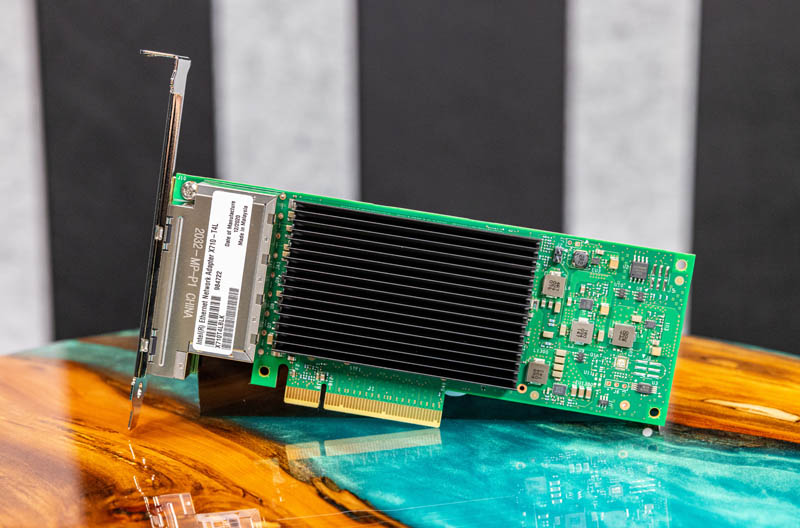
Moving to the rear, there is not much going on here. We will notice that this is a low-profile card. As a result, one can see the ports are actually offset slightly from the main PCB to be able to both fit all four ports in a low-profile card and also to have an easy-to-reach screw. That screw is used to change to a low-profile bracket.
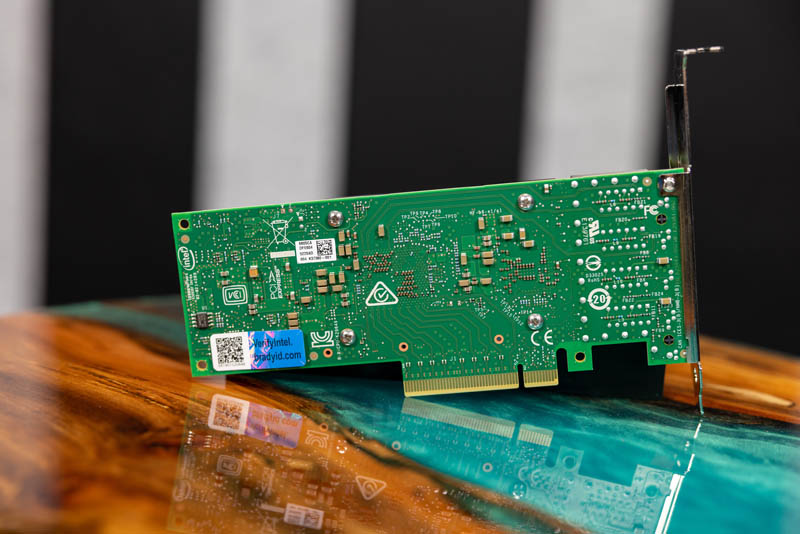
Here is a view of how the ports are offset to be a bit lower on the card. Something that is interesting is that although this card supports 2.5GbE and 5GbE speeds, the faceplate does not mention those. We mention this because users who are looking at servers installed in racks while servicing may assume that the lack of 2.5GbE and 5GbE markings mean that this is the older X710-T4 version.
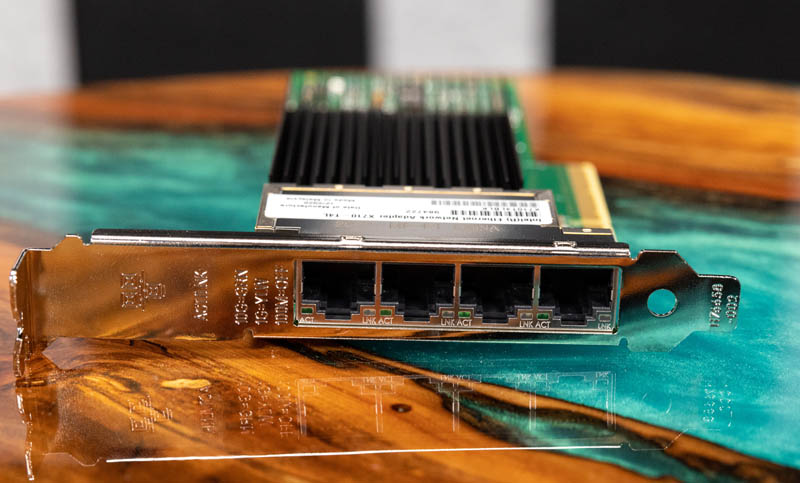
Overall, this is a low-profile quad-port NIC, but what makes the new version special are the new features.
Intel X710-T4L vs. X710-T4
Some may wonder what the difference is between these two cards. First, here again is the X710-T4L heatsink:

Here is the X710-T4 heatsink:
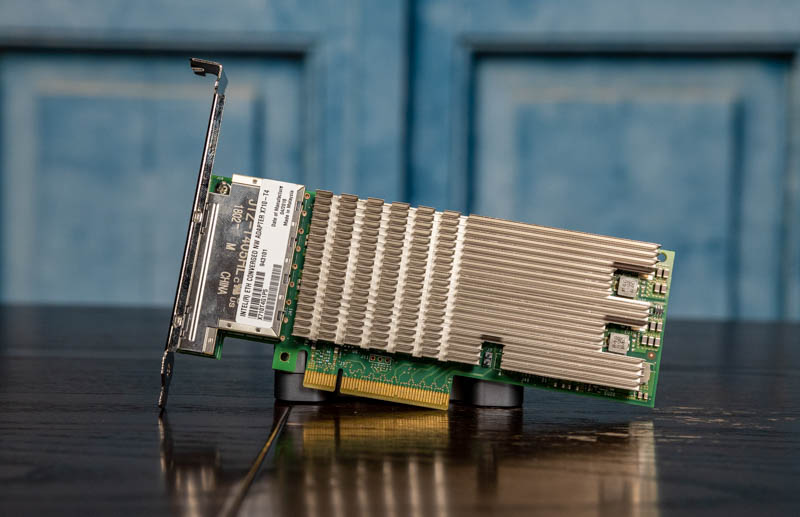
As one can quickly tell, the new version has a significantly smaller heatsink. A big reason for that is that Intel lowered the power ratings of these cards. As examples:
Typical power for quad-port 10Gbase-T:
- Intel X710-T4L: 13.6W
- Intel X710-T4: 24.7W
Maximum power for quad-port 10Gbase-T:
- Intel X710-T4L: 14.2W
- Intel X710-T4: 28.9W
Maximum quad-port 1Gbase-T:
- Intel X710-T4L: 7.5W
- Intel X710-T4: 18.1W
Roughly speaking, the new “L” cards use about half the power of the previous generation. Four years make a big difference.
Here is the official table for the X710-T4L and X710-T2L to see the multi-gig power numbers as well:
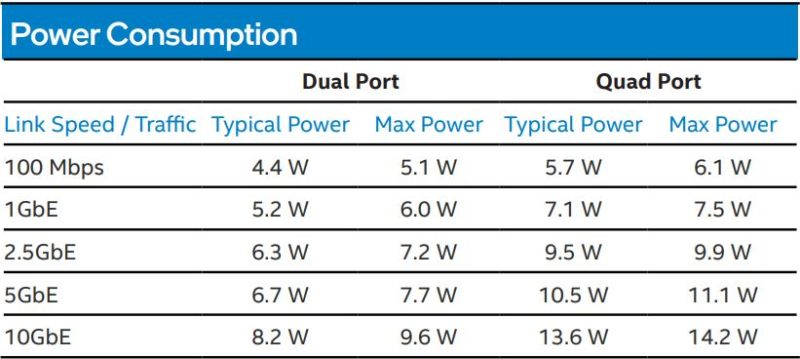
In terms of controller differences, there is more as well. The Intel X710-T4 has the Intel X710 controller while the X710-T4L uses the X710-TM4. That changes a number of options. Both are rated for CAT6 to 55m and CAT6a up to 100m at 10Gbase-T speeds. The X710-T4L is rated for up to 100m using 2.5Gbase-T 5Gbase-T even on CAT5e/ CAT6. So the new unit is compatible with 2.5GbE/5GbE longer runs on many existing wiring segments where the older card is not.
Here is the ethtool output for the X710-T4L:
Supported ports: [ TP ]
Supported link modes: 100baseT/Full
1000baseT/Full
10000baseT/Full
2500baseT/Full
5000baseT/Full
Supported pause frame use: Symmetric
Supports auto-negotiation: Yes
Supported FEC modes: Not reported
Advertised link modes: 100baseT/Full
1000baseT/Full
10000baseT/Full
2500baseT/Full
5000baseT/Full
Advertised pause frame use: No
Advertised auto-negotiation: Yes
Advertised FEC modes: Not reported
Speed: 10000Mb/s
Duplex: Full
Port: Twisted Pair
PHYAD: 0
Transceiver: internal
Auto-negotiation: on
MDI-X: Unknown
Supports Wake-on: g
Wake-on: g
Current message level: 0x00000007 (7)
drv probe link
Link detected: yes
Here is the ethtool output for one of the ports on the X710-T4 card:
Supported ports: [ TP ]
Supported link modes: 100baseT/Full
1000baseT/Full
10000baseT/Full
Supported pause frame use: Symmetric
Supports auto-negotiation: Yes
Supported FEC modes: Not reported
Advertised link modes: 100baseT/Full
1000baseT/Full
10000baseT/Full
Advertised pause frame use: No
Advertised auto-negotiation: Yes
Advertised FEC modes: Not reported
Speed: 10000Mb/s
Duplex: Full
Port: Twisted Pair
PHYAD: 0
Transceiver: internal
Auto-negotiation: on
MDI-X: Unknown
Supports Wake-on: g
Wake-on: g
Current message level: 0x00000007 (7)
drv probe link
Link detected: yes
The newer controller adds support for 2.5GbE and 5GbE speeds so it is not just a power consumption upgrade.
Intel X710-T4L Performance
We received about the performance we would expect from a solution like this. First, we looked at quad 10Gbase-T performance:
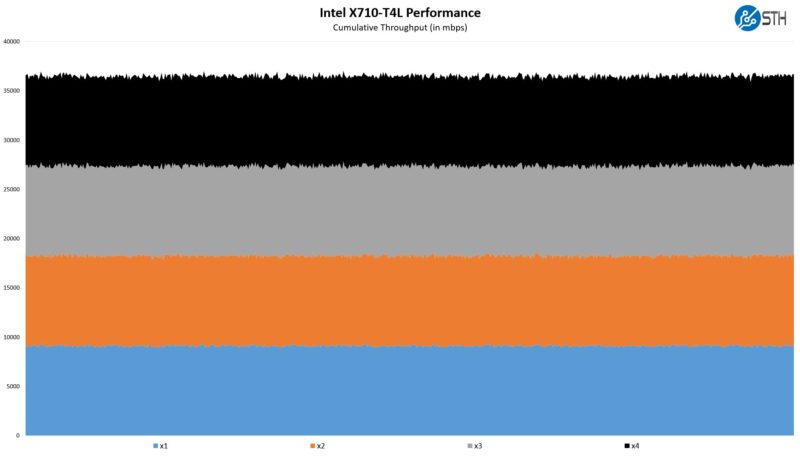
Next we looked at multi-gig performance running at 1GbE, 2.5GbE, 5GbE, and 10GbE speeds:
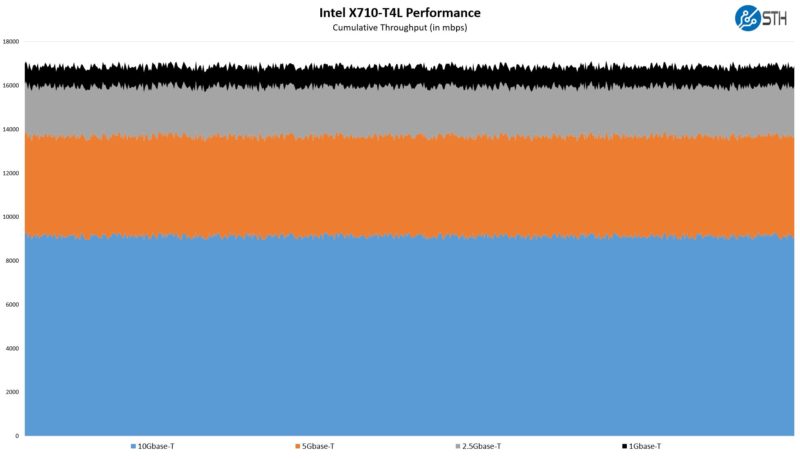
This is fairly basic testing, but we were able to confirm that the new multi-gig functionality is working. That is what we would want to see from this NIC.
Final Words
While to a casual observer the Intel X710-T4L and the X710-T4 may seem like very similar parts, they actually present a generational gap. When we discuss Intel CPUs, we discuss generation-on-generation performance improvement. Here, we get new multi-gig features and effectively half the power consumption.

One other difference that we did not mention is pricing. The new list price for the X710-T4L is around $100 less than the older X710-T4 (roughly $500 versus $600 but street pricing is different.) So lower pricing, lower power, and more features feel like this is an obvious choice. If you are buying a new quad-port 10Gbase-T NIC, the Intel X710-T4L is our clear recommendation over the X710-T4 at this point.

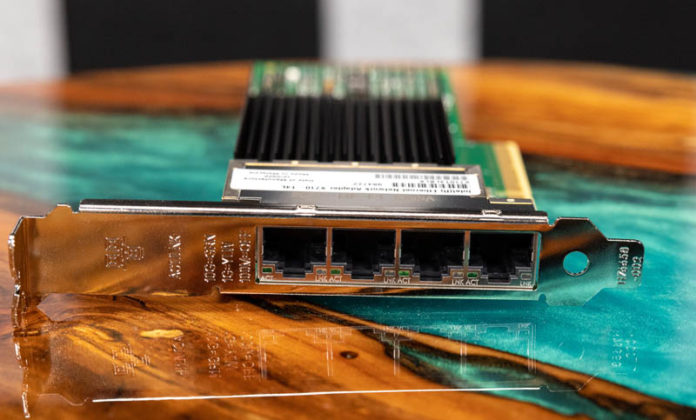



Great review, I have been looking for this version :)
Finally under 5W per port, I wonder if 10Gbps could make ways to consumers space.
$503 – $521 MSRP on Ark Intel.
$650 – $680 brand new on eBay. Scalpers are really scalping everything.
Dumps from data centers on eBay are still the way to go for individuals but forget about 2.5 and 5 GbE auto-negotiation with these used 10 GbE cards.
Is there a general consensus about SFP+ vs RJ45 for 10Gb NICs/switches?
A few years ago I started using 10GBase-T (Intel T540 IIRC) but when I was looking for switches and more NICs it was hard to find anything available.
Then more recently I have seen (because of this website) that MikroTik had several options that would work.
So if you were building out your lab or datacenter right now what would you use?
Presumably a die-shrink, process-node improvement?
At this price point why not get one of the newer Intel 810-series card with RDMA, like the E810-XXVDA4. It’s $150 more but supports 25/10 GbE, as well as iWarp and also (finally) RoCE.
This card’s pricing gives it no home to me, when you could get a cheaper quad port card or move up to an 810.
@B5Geek “So if you were building out your lab or datacenter right now what would you use?”
Assuming you need a 10G backbone, I’d go SFP+, as it’s more versatile wrt media. Put DACs between the switch and servers/NASes, some fiber from the lab(datacenter) to the switch in the family room(office), RJ-45 if you have a legacy device that would cost more to upgrade than it’s worth… Ends up both cheaper to build out and lower power in the long run, as you typically end up with more DACs than anything else if you focus on it.
@efahl: Thanks, that matches my gut feeling too. The upgrade path (and compatibility) of SFP+, QSFP giving you 100Gb/s and more is too tempting to ignore.
Any data on latency? This message (two X710-T2Ls: “I got RTTs in the .7ms range”) on intel’s forum seems notable:
https://community.intel.com/t5/Ethernet-Products/What-kind-of-latency-to-expect-from-a-X710-T2L/m-p/1306707/highlight/true#M26192
ehw: The real kicker is on the second page where the user is basically told that since they are not a company they can’t have access to the information they’re looking for: community.intel.com/t5/Ethernet-Products/What-kind-of-latency-to-expect-from-a-X710-T2L/m-p/1321746#M26932
It sounds to me like it might be a power-saving issue, considering they’re testing with pings – not sure they would have the same result if the card were actively being used. But the support experience doesn’t seem to have worked out in an ideal way for either party.
FYI, it is PCIe 3.0 x8 card.
Hi, i have this card and i have problem on newest mainboard with i9..
Pc with this card no boot, freezing on startup screen.
Any suggestion?